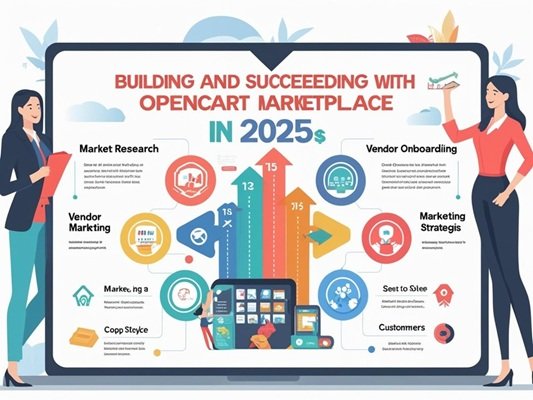OpenCart Marketplace: Complete Guide to Building Your Multi-Vendor eCommerce Platform in 2025
In today’s fast-evolving digital economy, building a multi-vendor eCommerce platform is one of the most promising business models. Whether you’re inspired by Amazon, eBay, or Etsy, the idea of hosting multiple sellers and earning commissions can be a lucrative venture. OpenCart Marketplace is one such solution that offers the flexibility, scalability, and affordability to make this vision a reality.
In this comprehensive guide, we’ll cover everything you need to know about creating a successful OpenCart Marketplace—from setup and configuration to choosing the right extensions, managing vendors, and optimizing your store for growth.
Table of Contents
-
What is OpenCart Marketplace?
-
Benefits of Using OpenCart as a Multi-Vendor Platform
-
Key Features of OpenCart Marketplace
-
Best Multi-Vendor Marketplace Extensions for OpenCart
-
How to Set Up Your OpenCart Marketplace
-
Vendor Management and Commission Setup
-
Payment and Shipping Integrations
-
Security and Performance Optimization
-
SEO and Marketing Tips for OpenCart Marketplace
-
Top Themes for OpenCart Marketplaces
-
Mobile Responsiveness and App Integration
-
Case Studies: Successful OpenCart Marketplaces
-
Pros and Cons of Using OpenCart for Marketplaces
-
Frequently Asked Questions (FAQ)
-
Conclusion
1. What is OpenCart Marketplace?
OpenCart Marketplace is a multi-vendor platform built using the OpenCart CMS. It allows multiple sellers or vendors to register, list products, and manage their orders within one centralized store, while the admin manages the overall platform, earns commissions, and ensures smooth operations.
OpenCart itself is a free, open-source eCommerce solution that’s widely popular for its ease of use, flexibility, and large developer community.
2. Benefits of Using OpenCart as a Multi-Vendor Platform
-
✅ Cost-Effective: OpenCart is free to use. Most extensions are affordable.
-
✅ Modular Architecture: Easily extend features using modules.
-
✅ Customizable: OpenCart supports themes, custom development, and third-party integrations.
-
✅ Large Community Support: Thousands of developers and forums.
-
✅ Multi-Language and Multi-Currency Support: Essential for global marketplaces.
3. Key Features of OpenCart Marketplace
| Features | Description |
|---|---|
| Vendor Dashboard | Dedicated dashboard for sellers to manage products, orders, and shipping. |
| Admin Controls | Full control over vendors, products, commissions, and approvals. |
| Commission Settings | Global and individual commission settings for sellers. |
| Product Management | Sellers can add/edit their products with images, pricing, and stock levels. |
| Order Management | Vendors can process their own orders and manage deliveries. |
| Review & Rating System | Customers can rate both products and vendors. |
| Withdrawal Requests | Vendors can request earnings withdrawal after admin approval. |
| Notification System | Emails and system alerts for vendor and admin activities. |
4. Best Multi-Vendor Marketplace Extensions for OpenCart
To transform your OpenCart store into a marketplace, you’ll need an extension. Below are some of the top-rated multi-vendor extensions:
| Extension | Features | Pricing |
|---|---|---|
| Webkul Multi Vendor Marketplace | Vendor profiling, commission management, product approval, shipping integration | Starts at $299 |
| Purpletree Multi Vendor Marketplace | Easy UI, vendor chat, SEO-friendly URLs, and vendor panels | Starts at $199 |
| Knowband Marketplace Extension | Category restrictions, seller dashboard, vendor payout | Starts at $250 |
| TMD OpenCart Marketplace | Order management, feedback system, vendor earning | $150 – $300 |
5. How to Set Up Your OpenCart Marketplace
Here’s a step-by-step guide to setting up your OpenCart Marketplace:
1: Install OpenCart
-
Download OpenCart from the official site.
-
Upload it to your server and follow the installation wizard.
2: Install a Multi-Vendor Extension
-
Choose an extension (like Webkul or Purpletree).
-
Upload files via FTP or Extension Installer.
-
Configure settings in the admin panel.
3: Configure Vendor Permissions
-
Set roles and permissions for vendors.
-
Enable/disallow access to product listing, order management, etc.
4: Customize Your Theme
-
Use a marketplace-ready theme or purchase one from ThemeForest or TemplateMonster.
-
Customize headers, menus, and product layout for multi-vendor visibility. 5: Set Up Payment & Shipping
-
Integrate with Stripe, PayPal, Razorpay, or other gateways.
-
Define shipping zones and methods for vendors.
6. Vendor Management and Commission Setup
-
Vendor Registration: Allow sellers to register using a form.
-
Approval System: Enable manual vendor approval for quality control.
-
Commission Settings:
-
Global (site-wide) percentage
-
Vendor-specific rates
-
Category-wise commission
-
-
Payout Handling: Enable vendors to request withdrawals after reaching minimum thresholds.
7. Payment and Shipping Integrations
| Integration | Purpose | Recommendations |
|---|---|---|
| PayPal | Global Payments | Ideal for worldwide sellers |
| Stripe | Card processing | Secure and flexible |
| Razorpay | India-based sellers | Easy integration |
| Shiprocket | Shipping automation | Support Indian logistics |
| Aramex / DHL / FedEx | Global shipping | Real-time tracking |
8. Security and Performance Optimization
-
SSL Certificates: Mandatory for secure vendor and buyer transactions.
-
Captcha & Anti-Spam: Protect registration and contact forms.
-
Limit Admin Access: Role-based restrictions for vendors and staff.
-
Cache & CDN: Use Varnish, Cloudflare, or Redis for speed.
-
Database Optimization: Regular backups and table optimization.
9. SEO and Marketing Tips for OpenCart Marketplace

-
Yoast SEO for OpenCart: Use plugins to optimize metadata, sitemaps, and keywords.
-
SEO-Friendly URLs: Enable clean, human-readable URLs.
-
Google Shopping Feed: Promote products on Google Shopping.
-
Email Marketing: Use Mailchimp integration to send product updates.
-
Social Media Sharing: Enable share buttons for each product.
-
Blog Section: Add a blog module to drive organic traffic via content marketing.
10. Top Themes for OpenCart Marketplaces
| Theme Name | Description | Price |
|---|---|---|
| Journal 3 | Highly customizable, responsive, supports multi-vendor | $59 |
| Fastor | Multiple demos, marketplace-ready | $49 |
| Sellegance | Clean, minimalist design | $45 |
| BigShop | Mega menu, product tabs, responsive | $39 |
11. Mobile Responsiveness and App Integration
With mobile commerce on the rise, it’s essential that your OpenCart Marketplace is mobile-friendly.
Mobile Optimization Tips
-
Use responsive themes.
-
Enable lazy loading for faster mobile browsing.
-
Minimize JavaScript on mobile.
Marketplace Apps
-
Develop Android/iOS apps using tools like Flutter or Ionic.
-
Some extensions offer pre-built apps for vendors and customers.
12. Case Studies: Successful OpenCart Marketplaces
| Marketplace | Description |
|---|---|
| CraftoCart | A marketplace for handmade products using OpenCart + Webkul |
| TechShoppy | Tech gadgets marketplace with multiple sellers |
| FurniCart | Furniture and home decor marketplace |
These businesses leveraged OpenCart’s flexibility with custom extensions and aggressive SEO to scale.
13. Pros and Cons of Using OpenCart for Marketplaces
Pros
-
Free and open-source
-
Huge community
-
Easy vendor and commission management
-
Lightweight and fast
Cons
-
Requires technical knowledge for complex setups
-
Limited native features—depends on extensions
-
Performance can degrade without optimization
14. Frequently Asked Questions (FAQ)
Q1: Is OpenCart free for building marketplaces?
Yes, OpenCart is free. However, you’ll need to purchase multi-vendor extensions and possibly hosting, themes, and services.
Q2: Can I build a marketplace like Amazon with OpenCart?
You can build a similar structure, though you’ll need custom development for advanced features.
Q3: How do vendors get paid?
through your configured payment methods. Most marketplaces manually transfer vendor earnings post-order fulfillment.
Q4: Is OpenCart scalable for large marketplaces?
Yes, but you must optimize caching, hosting, and database performance as traffic grows.
15. Conclusion
Launching an OpenCart Marketplace in 2025 is not only feasible but also strategic for aspiring entrepreneurs and businesses seeking to capitalize on the multi-vendor eCommerce trend. With its flexible architecture, cost-effective modules, and a vast global community, OpenCart provides all the essentials for marketplace success.
However, the key to thriving lies in choosing the right extensions, prioritizing user experience, and investing in SEO and marketing from the start. With careful planning and execution, your OpenCart-powered marketplace can become a go-to platform for both vendors and customers.
Important Information Table
| Topic | Details |
|---|---|
| Platform | OpenCart (Free & Open-Source) |
| Multi-Vendor Addons | Webkul, Purpletree, Knowband |
| Hosting Recommendations | A2 Hosting, SiteGround, Cloudways |
| SEO Tools | Yoast SEO, SEOPack, Blog Module |
| Payment Gateways | PayPal, Stripe, Razorpay, etc. |
| Key Feature | Vendor dashboard, commission management, product approval |
| Average Setup Cost | $200 – $1000 (incl. extension + theme) |
| Ideal For | Startups, SMEs, Niche eCommerce Platforms |
Read More: Techie Traffic


